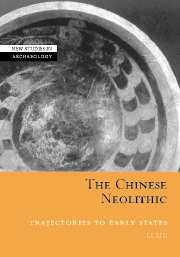Book contents
- Frontmatter
- Contents
- List of illustrations
- List of tables
- Preface
- Cambridge Cultural Social Studies
- 1 Setting the scene
- 2 The changing environmental contexts of China's first complex societies
- 3 Household subsistence and ritual
- 4 Spatial organization and social relations in communities
- 5 Community burial patterns
- 6 Development and decline of complex societies in the Central Plains
- 7 Development and decline of social complexity beyond the Central Plains
- 8 Trajectories toward early states
- 9 Reconstructing social processes
- Notes
- Appendixes
- References
- Index
5 - Community burial patterns
Published online by Cambridge University Press: 22 September 2009
- Frontmatter
- Contents
- List of illustrations
- List of tables
- Preface
- Cambridge Cultural Social Studies
- 1 Setting the scene
- 2 The changing environmental contexts of China's first complex societies
- 3 Household subsistence and ritual
- 4 Spatial organization and social relations in communities
- 5 Community burial patterns
- 6 Development and decline of complex societies in the Central Plains
- 7 Development and decline of social complexity beyond the Central Plains
- 8 Trajectories toward early states
- 9 Reconstructing social processes
- Notes
- Appendixes
- References
- Index
Summary
Hence the successor of Shao-hao, Chuan-hsu, charged Ch'ung, Governor of the South, to handle the affairs of Heaven in order to determine the proper place of the spirits, and Li, Governor of Fire, to handle the affairs of Earth in order to determine the proper places of men. And such is what is meant by cutting the communication between Heaven and Earth.
“Severance of heaven–earth communication” in Guoyu, a fourth-century BC textIntroduction
Approaches to mortuary remains have been debated by Western archaeologists, and their research foci have shifted from processual archaeology's reconstruction of social organization to post-processual archaeology's understanding of ritual practice (Pearson 1999). I view these two approaches as mutually complementary methods for the analysis of mortuary data. On the one hand, processual archaeological approaches regard the quantity and quality of grave furnishings as direct or indirect manifestation of social patterns, especially of social rankings (e.g., Binford 1971; Peebles 1971; Saxe 1970; Tainter 1973). On the other hand, post-processual approaches argue for contextual archaeology, which hypothesizes that the participation of survivors in funeral rites may have contributed to patterns in mortuary practice (e.g., Hodder 1982a, 1982b). A careful analysis of depositional processes in archaeological records, with attention to the ritual activities involved, can provide great insight into both the symbolic meanings of burial patterns and the relationships between the living and the dead in the ritual context (Barrett 1988: 30–41; Thomas 1991).
- Type
- Chapter
- Information
- The Chinese NeolithicTrajectories to Early States, pp. 117 - 158Publisher: Cambridge University PressPrint publication year: 2005

